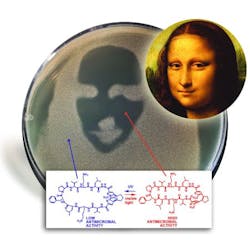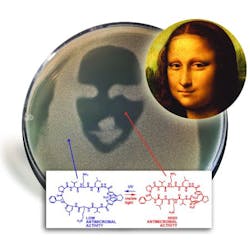New photoswitchable antibiotic could reduce side effects in local infection treatment
Scientists from the Karlsruhe Institute of Technology (KIT; Germany) and the University of Kiev (Ukraine) have produced an antibiotic whose biological activity can be controlled with light. Thanks to the diarylethene photoswitch, the antimicrobial effect of the peptide mimetic can be applied in a spatially and temporally specific manner. The new antibiotic might open up new options for treatment of local infections, as it reduces side effects.
Related: Photo-switchable peptides promise precision control of drugs, and limited side effects
Photoswitchable molecules such as diarylethene modify their structure and properties when exposed to light of an adequate wavelength. By reversible photoisomerization (a reversible light-induced internal relocation of the molecule), the open form is turned into a closed form. Such photoswitchable molecules are applied in molecular electronics and many other areas. Particularly interesting opportunities result from the insertion of photoswitches into biomolecules to control their activity by light. Interest focuses on so-called peptide mimetics, compounds whose major structural elements emulate a peptide (a small protein).
The team of scientists—led by Professor Anne S. Ulrich, director of the Institute for Biological Interfaces 2 (IBG2) and holder of the Chair for Biochemistry at the Institute of Organic Chemistry (IOC) at KIT—has produced a photoswitchable peptide mimetic based on a diarylethene scaffold that can be photoisomerized reversibly. The scientists modified this building block into an amino acid analog and incorporated it directly into the backbone of the annular peptide antibiotic Gramicidin S. Biological activity of the resulting peptide mimetic can be controlled spatially and temporally with the help of ultraviolet (UV) and visible light. To demonstrate this, the scientists treated a bacterial film with the inactivated antibiotic and exposed it to light via a mask. As a result, the photoswitchable diarylethene was converted from a closed into an open form. Due to the structural modification induced, the entire substance molecule had a much higher antimicrobial effect.
"In the future, such photoactivable antibiotics might be used as smart therapeutic agents against local bacterial infections," Ulrich explains. “Usual side effects can also be minimized by switching.”
Based on this strategy, new peptide-based agents against cancer might be feasible, as the newly developed photoactivable building block can also be applied in other peptide sequences.
Full details of the work appear in the journal Angewandte Chemie; for more information, please visit http://dx.doi.org/10.1002/anie.201310019.
-----
Follow us on Twitter, 'like' us on Facebook, and join our group on LinkedIn
Subscribe now to BioOptics World magazine; it's free!

